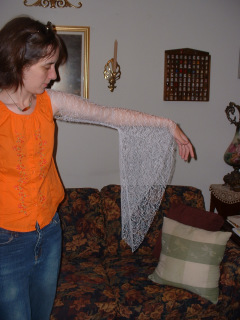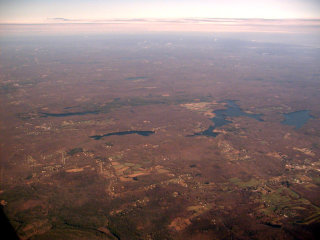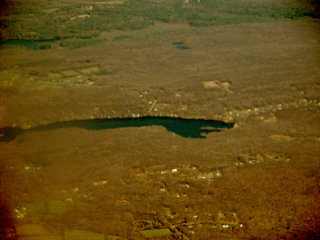Some observations on the
Phantasmabiology
of 'Potamoi
by Mary Sawyer and Dana Sawyer
Contents
A note about 'potamology
Introduction to 'potamoi
'Potamoi in
their natural habitat
The
Eastern Connecticut 'Potamological Field Research Station (ECPFRS)
Spring at ECPFRS: Preliminary
Investigations
'Potamology takes
to the air
Winter at ECPFRS: Squirrel
blames local 'potamoi
'Potamoi and Global
Warming
'Potamoi on the Potomac:
a Utopian vision
Recycled Monitors
'Potamoi on the Move
The Education
of a 'Potamologist
A note about
'potamology
The term 'potamology, as used here,
refers to the
study of 'potamoi; it is not to be confused with the study of
rivers. Whether 'potamoi are the same as potamoi (sans
apostrophe) remains to be seen, but it is important to remember that
'potamology is a branch of phantasmabiology, and as such is, to the
best of our current knowledge, concerned with imaginary -- or at least
improbable -- animals.
Introduction to
'potamoi
'Potamoi superficially resemble the African hippopotamus, but they
are found mainly in our imaginations and therefore they tend to live in
imaginary places such as Potamogonia, Botswagonia, and eastern
Connecticut.
Also, they are somewhat smaller and shyer than the African
hippopotamus,
so they often go unnoticed even where they are living side by side
with humans.
The brief excerpts that follow are drawn from our extensive
research
on the phantasmabiology of 'potamoi, but even so, this will be no more
than the briefest introduction to the subject. The definitive
work
on the phantasmabiology of 'potamoi has yet to be written, but will
eventually appear in forthcoming volumes of the essential but elusive Acta 'Potamologica.
'Potamoi
in their natural habitat
In Potamogonia, the 'potamoi live in an exquisite balance with the
local ecology. A Potamogonian correspondent writes:
If you ever have a chance, be sure to visit
Potamogonia in
'potamusweed season. This prolific plant grows abundantly on
the
surface of lakes and streams, buoyed up by its large hydrogen-filled
pods.
It would completely block everything, except that great fleets of
'potamoi
come and swim side by side munching it up. At some point when
they
have eaten enough, the 'potamoi become airborne, and the gentle trade
winds
waft them over the sand dunes and out to sea. Then with a
distant
burping sound they settle down on the waves and swim back to
shore.
Another splendid example of 'potamoi at work, making the world a better
place (and having fun at the same time)!
The
Eastern Connecticut 'Potamological Field Research Center
Even as the process of equipping
the Eastern
Connecticut 'Potamological Field Research Center (ECPFRS) continues,
our
field 'potamologists are gathering important observations.
Here
is an initial report dated November 30, 2003:
A few young 'potamoi were spotted this evening on the shores
of
Pickerel Lake. These appear to be a previously unknown
species
of 'potamus, descended, no doubt, from ice-age Connecticut River Valley
'potamoi who adapted to suit a glacier-ridden environment (the
geological history of the Connecticut River Valley is available at
several wonderful websites that I can't for the life of me
remember...oddly, as I recall, none of these mentions the role of the
'potamus...). The unique evolutionary history of these
Pickerel
'potamoi is evident from their shaggy fur coat, which resembles the fur
of the otter. Apparently, the Pickerel 'potamoi use potamusweed for an
interesting purpose...after munching on bits of autumnal potamusweed,
they were observed hiccoughing gently into the downy under-layer of
their winter coats, creating a bubble-layer which, it can be presumed,
affords them extra protection from the chilly waters of Pickerel Lake.
This field researcher is encouraged by the results of a mere five days
of ownership of the new ECPFRS and hopes that close observation of this
newly discovered species will enrich current 'potamological
understanding.
Follow-up report from December 7, 2003:
Possible sighting of 'potamus tracks in snow today at
ECPFRS...
'potamoi in question may have been in search of alternative food
sources due to recent heavy snowfall... the distance between footprints
suggests 'potamoi were using small supply of 'potamus weed to maintain
low level of buoyancy, bouncing toward their winter food supply like
astronauts on the surface of the moon.
This unusual locomotion of Pickerel 'potamoi in deep snow, if
confirmed, is further evidence of a unique Ice Age
adaptation.
Additional research is needed to verify that Pickerel Lake is of
glacial origin. If so, Ice Age 'potamoi may simply have
settled
in
as the glaciers retreated, and have probably been there at least since
the draining of Lake Hitchcock at the end of the Ice Age.
One web
site on the geological history of the Connecticut River Valley is
provided by the University
of Massachusetts.
Spring at ECPFRS:
Preliminary investigations
Springtime has brought donations of new equipment, and a great increase
in activity at ECPFRS. Two canine staff members have joined
the
research effort, and are currently being trained in the unobtrusive
detection of 'potamoi. An initial expedition in the Center's
new
watercraft provided field
training for the canine assistants and revealed rich 'potamoi habitat,
as described in this report from the
field:
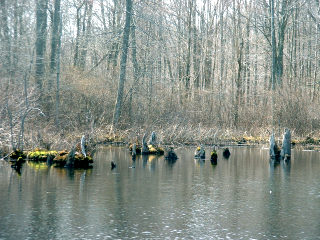 Attached
are some photos from Thursday's (4/22/2004) expedition by local
'potamologists... Thanks to recent generous donations, we are now able
to survey the local lake-fauna for signs of 'potamoi. As you
can
see, there are several prime 'potamus locations on Pickerel Lake
(left).
Attached
are some photos from Thursday's (4/22/2004) expedition by local
'potamologists... Thanks to recent generous donations, we are now able
to survey the local lake-fauna for signs of 'potamoi. As you
can
see, there are several prime 'potamus locations on Pickerel Lake
(left).
These 'potamus-sized islands are
surrounded by 'potamus weed
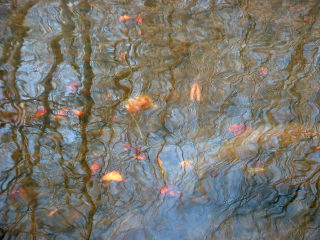
.
Though it's still growing towards the surface, our observations lead us
to expect a bumper crop for the summer migration!.
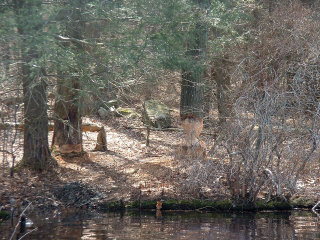 The
existence of several well-gnawed trees along the bank (left) conjures
up images of beaver/'potamus cooperation the likes of which have yet to
be observed!
The
existence of several well-gnawed trees along the bank (left) conjures
up images of beaver/'potamus cooperation the likes of which have yet to
be observed! 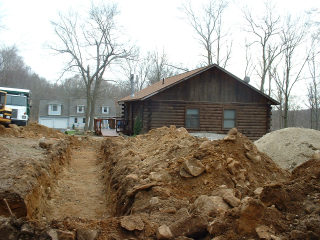
Although attempts to photograph local
'potamuses
have been unsuccessful, and our excavation in search of evidence of
ice-age 'potamolotical activity progresses slowly... it is an exciting
time for phantasmazoologists!
(Preliminary stratigraphic test
trench revealed boulder at far right, possibly used by ice-age
'potamoi.)
'Potamology
takes to the air
Although few details have yet been
revealed, the
pictures below show an intrepid ECPFRS 'potamologist evaluating
arm-mounted airfoil mock-ups in preparation for 'potamoi migration
season. Evidently the 'potamologist will ingest a suitable
quantity of 'potamus weed in order to maintain altitude as she tracks
the airborne 'potamoi. Note flight goggles and orange blouse
for
high visibility. The blouse is equipped with integral arrays
of
miniature retroreflectors to facilitate continuous ground-based laser
ranging during flight.
Airfoil prototype #1 (photo at left above) doubles as a
plankton net
for investigations of the 'potamoi food chain. However, there
is
some concern that its aerodynamics may be inferior to #2 and #3.
In order to visualize the appearance of Pickerel Lake to
migrating
'potamoi, we have conducted preliminary aerial reconnaissance from
fixed-wing aircraft. (The junior canine assistant firmly
believes
he is visible in the picture at right below.)
Winter at ECPFRS: Squirrel
blames local 'potamoi
In early January 2005,
we received the following report from our hardy field staff at ECPFRS:
Victor recently spotted a furry ice-age 'potamus
living
quite peacefully in a drift of snow on the garage foundation.
We
were hopping in our SUV (a sure-fire way to attract 'potamoi) when he
saw it dart into a small hole between the snow and the cement wall of
the foundation. The distinct lack of footprints in the snow
when
we got out for a closer look points to definite 'potamus-weed-buoyed
winter 'potamoi activity. We we relieved to see this
'potamus, as
we have not had much opportunity to 'potamus-watch this winter
(although a squirrel I recently scolded for knocking down our
birdfeeder tried to blame it on local 'potamoi).
Squirrel (Sciurus sp.) interviews are a novel and
still experimental method of
'potomological investigation. The reliability of observations
reported by squirrels is uncertain. In this case, the
squirrel
may have been truthful, or it may just have been making an unwarranted
and squirrelous allegation.
'Potamoi and
global warming
Like many other animals, 'potamoi are expected to gradually
shift their
natural range due to ongoing climate change. Like 'possums,
'potamoi
may someday be common in New England, if present trends
continue.
Perhaps they are here already, passing unnoticed among the endemic
herds
of pedestrians in Harvard Square, or steaming peacefully up the Mystic
River. (Indeed, since this was originally written, increasing
numbers and varieties of 'potamoi have been discovered in Connecticut,
though some of these may be derived from persisting Pleistocene
'potamoi populations which apparently continue to radiate from cryptic
refugia deep within the complex post-glacial ecosystem.)
An observer in Wakefield Massachusetts, writing during the
rainy summer
of 1998, expected the imminent arrival of 'potamoi:
Ecologists tell us that the northerly range of
'potamoi has
until now been constrained by the relatively harsh climate of New
England.
Fortunately for 'potamoi, the boreal climax forest is rapidly being
succeeded
by tropical swampland. I expect to see 'potamoi cruising down
our
flooded streets any day now.
As our streets become deep placid waterways supporting
diverse and luxuriant
vegetation, not only 'potamoi, but also manatees will move north in
increasing
numbers.
So will 'potamoi come steaming up the Saugus River to
Wakefield, or
will they come north in K cars like everybody else? Perhaps
some
of each. Ecologists are watching closely to see how this
phenomenon
develops. Meanwhile, more rain is predicted.
Potamoi have not yet been seen on the Saugus River, but
Wakefield is
preparing to welcome them. Town Meeting decided to buy the
Lanai
Island site and turn it into a park, complete with a little bridge over
the Saugus River where it originates at Lake Quannapowitt.
When the
Potamoi arrive, we will all stand on the bridge to welcome
them.
They will be the first 'potamoi in Wakefield since the woolly 'potamoi
of the Ice Age -- or were those woolly rhinoceroi? Anyway, we
are
preparing to welcome them all the same.
However, a 'potamoi spotter in New Jersey reported that 'potamoi in her
region had largely abandoned aquatic travel:
Most of the potamoi I've seen have been traveling in
K cars,
however, if they can get a whole herd together, they sometimes rent an
RV. They like to travel in vehicles that can be referred to
by letter
(K cars, RVs, ATVs, SUVs, etc.). No one really
knows why.
Unfortunately, 'potamoi have been slower to arrive than expected, and
dry
conditions in 2002 quite likely have further postponed the arrival
of 'potamoi in eastern Massachusetts, whatever their means of
transportation.
Still, those furtive shadows in the Red Line stations may be
'potamoi. (Update: heavy rainfall in the spring of 2006 gives
us
new hope of sighting 'potamoi in Massachusetts.)
Our field researchers have also looked for a northward
extension of
'potamoi into the pleasant climes of Ohio. In a memo to field
staff,
one of our researchers confidently wrote:
The many lakes and rivers of Ohio could make it a
favorite
destination for 'potamoi. Not since a local mistook Robert
Fulton's
first steamboat for "the devil riding a sawmill up the river to Albany"
has there been such a notable sight on the Hudson as will be presented
by fleets of 'potamoi. From there, the Mohawk River leads a
short
distance to Schenectady, where they can visit the former habitats of
their
friend Charles Proteus Steinmetz. Then westward through the
Erie
Canal past many beautiful small lakes and finally to Buffalo.
From
there it is but a short detour up the river to visit Niagara Falls
before
cruising into the vast expanses of Lake Erie.
'Potamoi will doubtless keep land in sight as they cruise
toward Cleveland,
mindful of the sudden storms for which the Great Lakes are so
famous.
At Cleveland, the Cayahoga River leads inland to Akron, and from there
a network of rivers, lakes, and reservoirs gives ready access to almost
every part of the state. Indeed, it is a veritable 'potamoi
playground,
with few places more than five miles from 'potamoi-navigable waters.
Of course, the 'potamoi potential of neighboring
Pennsylvania, together
with Ohio and upstate New York already mentioned, should not be
neglected.
These regions could become great new centers of 'potamoi
culture.
Just as the newly independent United States expanded its horizons to
these
very areas in the last days of the eighteenth century and the first
decades
of the nineteenth, so also could 'potamoi in the last of the twentieth
and the beginning of the twenty-first.
Unfortunately, initial reports from the field did not immediately
confirm
the expected presence of 'potamoi, but our field staff in Ohio remained
hopeful:
I kept an eye out for potamoi, and although I didn't
see any,
there were several very inviting clumps of green things on the
shore.
These may very well have hosted a shy, mid-western breed of potamoi.
Though New England 'potamoi also remain at best elusive, our
researchers
are still very excited about the potential of the northeastern United
States,
and especially the Boston area, as a 'potamoi habitat:
New England may become the big vacation spot for
'potamoi who
want to escape the harsh Potamogonian winter in July and
August.
The Fleet Center could be renamed the Hippodrome, and flooded for
'potamoi
water sports. The Public Gardens will be popular with
'potamoi, as
will Jamaica Pond. There's parking for hundreds of K cars
under the
Common.
Background information on global warming can be found at EPA
and Union
of Concerned Scientists.
Due to uncertainties of current climate models, the effect on 'potamoi
cannot be predicted in detail, but as warming becomes more severe, the
recently discovered Pickerel 'potamoi may react differently than their
less furry tropical cousins.
'Potamoi on the
Potomac: a Utopian vision
Some say the Potawatomi Indians gave the river Potomac its name because
it would be such a natural place for 'potamoi. Others say
that since
the Potawatomi lived in Michigan, they probably didn't name anything on
the East Coast -- unless they were peripatetic Potawatomi, which is
possible.
Be that as it may, the lovely aroma of cigar smoke spreading
across
Foggy Bottom from the vicinity of the Congress not only banishes
mosquitoes,
but serves as a beacon for migrating 'potamoi, calling to them across
the
waves, directing them safely through Chesapeake Bay and up the
Potomac.
Upon arrival in the alabaster city, they can make a brief detour on the
L4 bus to visit the National Zoo, then take up residence in nearby Rock
Creek Park, or settle on the mud flats of the Anacostia River, or
migrate
up the Potomac to the rural splendors of Mary-land.
The 'potamus lobby will become very influential; they will
carry great
weight in the halls of Congress. 'Potamoi will stand for
responsible
government, old-fashioned values, and habitat preservation.
Not since
the ancient glory of Hippo Regius will there have been a city so
blessed
with the influence and wisdom of 'potamoi. And as the
capitol, so
the nation, until it shines with 'potamoi from sea to sea.
Recycled monitors
One of our field researchers has recently filed some remarkable
observations
from Potamogonia:
Strange that you should ask about computer
monitors...evidently,
large numbers of computer monitors have been escaping the confines of
human
service and migrating to Potamogonia to live in freedom among the
'potamoi.
Among these escaped monitors, a phenomenon is occurring the likes of
which
phantasmazoologists have never seen before, and which they are, so far,
unable to explain.
For some reason, after just a few months among the 'potamoi,
these monitors
begin to exhibit strange, reptilian qualities, basking in the sun for
hours
at a time, displaying intricate screen savers that, much like the skin
of a chameleon, provide camouflage within the constantly changing flora
of Potamogonia. Indeed, these monitor-lizards have evolved
rapidly,
and are flourishing in the fertile Potamogonian environment.
Although
ferocious in appearance, they are actually quite gentle, and as far as
phantasmazoologists on the scene can tell, completely
vegetarian.
Largely nocturnal, they spend most of the day snoozing in the hot
Potamogonian
sun, relying on their intimidating appearance, sophisticated
camouflage,
and basically nonfood-like appearance to protect them from
predators.
Unlike many non-native species, monitor-lizards do not seem to be
interfering
with the other inhabitants of Potamogonia, a fact which comes as a
great
relief to observers of the Potamogonian 'potamoi. Further
observation
of the monitor-lizard is necessary, and phantasmazoologists are eager
to
undertake this new field of study.
In the interests of science, I may wish to release the
monitor from
my computer into the wild to see if it develops any reptilian
characteristics.
Of course, I would need to replace it with another, more docile,
model.
Perhaps a smaller one, say about three to six inches less deep, would
be
less likely to become feral.
Updates on monitor-lizard activity, and their interactions
with 'potamoi,
may indeed follow if this phantasmazoologist does not get more sleep.
We will add new observations to this page from time to time as they
become available. So far we can report that the smaller three
to
six inch deep monitors currently employed by our researchers have not
shown any tendency to become feral. Perhaps they are less
fond of
heat than the older, larger monitors, or perhaps they simply haven't
yet reached the right age.
'Potamoi on the move
We received this interesting note from an intrepid 'potamologist in the
field:
Remembering the potamoic fascination with monogrammed
vehicles,
it is not surprising that I spotted some 'potamoi yesterday [March 9,
2002]
while riding through the Connecticut River Valley in an SUV.
Yesterday's
heavy fog and unseasonably high temperatures provided excellent
conditions
for these migratory 'potamoi as they crept northward. Similar
weather
conditions on the Northwest Coast have encouraged western 'potamoi to
explore
the dense woodlands of Washington and Oregon. According to
some reports,
'potamoi have been spotted wandering as far north as Vancouver,
B.C.
In light of the 'potamoi's aforementioned fascination with places and
cars
whose names contain abbreviations, their attraction to B.C. is no
surprise.
I feel further field research is necessary...
That may explain the special attraction for 'potamoi of
Washington
D.C., where all the street addresses have N.W., N.E., S.W., or S.E.
after them. Indeed, more research is clearly
indicated. For
example, are 'potamoi especially fascinated by Canadian and British
postal codes, which contain letters as well as numbers? To
date,
our field work in B.C. has been inconclusive on the importance of this
factor, as it is difficult to control for other environmental
differences between B.C. 'potamoi and their Washington and Oregon
counterparts. For example, despite the attractive green color
of
US currency, the 'potamoi may prefer to use Canadian one and two dollar
coins because of their damp habitat. On the other hand, the
new
US dollar coin may partly offset that advantage, even though it is not
presently available in a two dollar denomination. The
relative
resistance to corrosion of US and Canadian coins in damp 'potamoi
habitat is unknown.
We are also watching closely to discover whether 'potamoi will
transition
from K cars and SUVs to more efficient and environmentally friendly
vehicles
such as SULEVs, PZEVs, and HEVs. Only time will tell.
Perhaps they are
waiting for super ultra low emission hybrid SUVs. Meanwhile,
the city
government of New York has replaced some of their aging fleet of K cars
with
commercially available HEVs which also happen to be SULEVs (Toyota
Prius);
we do not know whether this change will have any effect on 'potamoi.
To further our research in this area ECPFRS phased out K
cars some years ago,
and for several years used a 2001 Prius SULEV for transport while maintaining an SUV
for backup transport and comparative studies.
Various
preliminary reports indicated that 'potamoi seemed to be attracted to the
Prius, but we never determined whether they found the SULEV more attractive than
the SUV. The fleet has now been upgraded again to a 2009 Prius
and a Honda Element, and a three-way comparitive study is in progress
to see whether 'potamoi gravitate toward either of these or toward the
propane tank.
The
Education of a 'Potamologist
No doubt many people
have wondered what
qualifications are necessary for research in 'potamology.
Because
'potamologists are almost as elusive as the 'potamoi they study, it is
difficult to generalize. The typical 'potamologist seems to
be an
amateur naturalist rather than a trained zoologist.
Educational
background varies widely, but one 'potamologist is known to have
attended a large midwestern university, where he majored in Applied
Troglodytics with minors in Plumbophony and Paleontology. Another
majored in sociology and French while attending a small liberal arts
college in the east, where 'potamoi may have dwelt unobserved among
large populations of gray squirrels and deer.
<-Home
Last updated October 24, 2009

 Attached
are some photos from Thursday's (4/22/2004) expedition by local
'potamologists... Thanks to recent generous donations, we are now able
to survey the local lake-fauna for signs of 'potamoi. As you
can
see, there are several prime 'potamus locations on Pickerel Lake
(left).
Attached
are some photos from Thursday's (4/22/2004) expedition by local
'potamologists... Thanks to recent generous donations, we are now able
to survey the local lake-fauna for signs of 'potamoi. As you
can
see, there are several prime 'potamus locations on Pickerel Lake
(left).  .
Though it's still growing towards the surface, our observations lead us
to expect a bumper crop for the summer migration!.
.
Though it's still growing towards the surface, our observations lead us
to expect a bumper crop for the summer migration!.  The
existence of several well-gnawed trees along the bank (left) conjures
up images of beaver/'potamus cooperation the likes of which have yet to
be observed!
The
existence of several well-gnawed trees along the bank (left) conjures
up images of beaver/'potamus cooperation the likes of which have yet to
be observed! 
